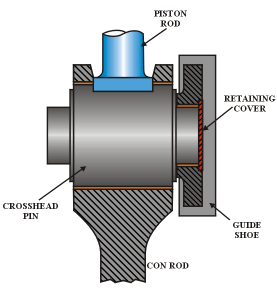Write the standing orders the Chief Engineer Officer should issue regarding the maintenance and safe and efficient operation of air compressors.
Outline any problems common to air receivers and machinery space/ship compressed air systems.

a.
Most of the problems with automatically operated air compressors lead to increased running hours. These include:
Leaking automatic drains - where the drain does not shut properly, due to dirt under the valve seat. Relief valves can also leak.
Unloaders not operating correctly.
Damaged or worn suction and discharge valves.
Dirty air filter
Leaks in compressed air system esp. auxiliary supplies to deck.
The increase in running hours may be gradual, and therefore go unnoticed. For this reason the running hours should be logged on a daily basis and any upward trend investigated and rectified. When possible the time taken to fill the air receiver should be tested and recorded.
Automatic drains not operating at all due to being choked with dirt can lead to a carry over of water/oil to the receiver. This can lead to an increase in corrosion, and a build up of oil film on the internal surfaces of the lines.
If a planned maintenance scheme is not in place or not applied effectively, then there is a chance that inefficiency of the air compressor due to the above or because of excessive wear will not be noticed until too late; i.e. when manoeuvering and the compressors cannot keep up with demand.
b.
Each Watch
Check oil level in sump; record amount used to top up. Do not overfill. Excessive consumption to be investigated. Any increase in crankcase pressure to be reported to 2/E to investigate and rectify
Drain air receiver of water .
Ensure that auxiliary air (esp. air to deck) is shut off when not in use.
Daily:
Record Running Hours
Check all automatic drains and unloader for correct operation.
Weekly:
check operation of relief valves fitted to intercooler, aftercooler, HP and LP stages by operating manually.
Planned Maintenance.
To be carried out as per instructions. Air filter to be changed every 500 hrs. Compressor valves to be removed for inspection and overhaul every 1000 hrs. Do not reverse compressor valve plates; there is a danger of them failing due to fatigue cracking. Every 2000 hours all automatic drains to be stripped, cleaned, checked and re-assembled. Relief valves fitted to LP, HP, intercooler and after cooler to be stripped, cleaned, overhauled and set at correct lifting pressures. Every 4000 hours: Major overhaul to be carried out as per manufacturers instructions.
c.
Corrosion is a problem common to receivers and systems. Water carry over in the air can lead to general corrosion and pitting. The air receiver is internally coated with a clear varnish to protect against this attack. Main air start lines are subject to survey, but should be regularly examined for corrosion/wastage. Oxidised lubricating oil carried over in the air can also cause corrosion. Air start pilot valves can corrode and jam preventing the engine starting. Corrosion in the main air start valve can cause the valve to stick in the open position, which is a potentially dangerous situation - possibility of an air start line explosion if there is oil present. For this reason and because of the aforementioned corrosive properties of oxidised oil, lub oil carry over must be kept to a minimum and every effort made to remove water from the system.






